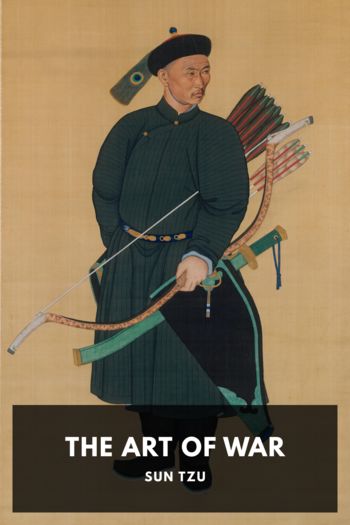The Art of War by Sun Tzu (elon musk reading list TXT) 📕

- Author: Sun Tzu
Book online «The Art of War by Sun Tzu (elon musk reading list TXT) 📕». Author Sun Tzu
An interesting document which has survived from the close of the Han period is the short preface written by the Great 曹操 Tsʽao Tsʽao, or 魏武帝 Wu Wei Ti, for his edition of Sun Tzǔ. I shall give it in full:—
I have heard that the ancients used bows and arrows to their advantage.19 The Lun Yu says: “There must be a sufficiency of military strength.”20 The Shu Ching mentions “the army” among the “eight objects of government.”21 The I Ching says: “師 ‘army’ indicates firmness and justice; the experienced leader will have good fortune.”22 The Shih Ching says: “The King rose majestic in his wrath, and he marshaled his troops.”23 The Yellow Emperor, Tʽang the Completer and Wang all used spears and battle-axes in order to succor their generation. The Ssǔ-ma Fa says: “If one man slay another of set purpose, he himself may rightfully be slain.”24 He who relies solely on warlike measures shall be exterminated; he who relies solely on peaceful measures shall perish. Instances of this are Fu Chʽai25 on the one hand and Yen Wang on the other.26 In military matters, the Sage’s rule is normally to keep the peace, and to move his forces only when occasion requires. He will not use armed force unless driven to it by necessity.27
Many books have I read on the subject of war and fighting; but the work composed by Sun Wu is the profoundest of them all. [Sun Tzǔ was a native of the Chʽi state, his personal name was Wu. He wrote the Art of War in 13 chapters for Ho Lu, King of Wu. Its principles were tested on women, and he was subsequently made a general. He led an army westwards, crushed the Chʽu state and entered Ying the capital. In the north, he kept Chʽi and Chin in awe. A hundred years and more after his time, Sun Pin lived. He was a descendant of Wu].28 In his treatment of deliberation and planning, the importance of rapidity in taking the field,29 clearness of conception, and depth of design, Sun Tzǔ stands beyond the reach of carping criticism. My contemporaries, however, have failed to grasp the full meaning of his instructions, and while putting into practice the smaller details in which his work abounds, they have overlooked its essential purport. That is the motive which has led me to outline a rough explanation of the whole.30
One thing to be noticed in the above is the explicit statement that the 13 chapters were specially composed for King Ho Lu. This is supported by the internal evidence of chapter I (“The general that hearkens to my counsel …”), in which it seems clear that some ruler is addressed.
In the bibliographic section of the Han Shu,31 there is an entry which has given rise to much discussion: 吳孫子八十二篇圖九卷 “The works of Sun Tzǔ of Wu in 82 pʽien (or chapters), with diagrams in 9 chüan.” It is evident that this cannot be merely the 13 chapters known to Ssǔ-ma Chʽien, or those we possess today. Chang Shou-chieh in his 史記正義 refers to an edition of Sun Tzǔ’s 兵法 of which the “13 chapters” formed the first chüan, adding that there were two other chüan besides.32 This has brought forth a theory, that the bulk of these 82 chapters consisted of other writings of Sun Tzǔ—we should call them apocryphal—similar to the 問答 Wen Ta, of which a specimen dealing with the Nine Situations33 is preserved in the 通典 Tʽung Tien, and another in Ho Shih’s commentary. It is suggested that before his interview with Ho Lu, Sun Tzǔ had only written the 13 chapters, but afterwards composed a sort of exegesis in the form of question and answer between himself and the King. 畢以珣 Pi I-hsün, the author of the 孫子敘錄 Sun Tzǔ Hsü Lu, backs this up with a quotation from the





Comments (0)